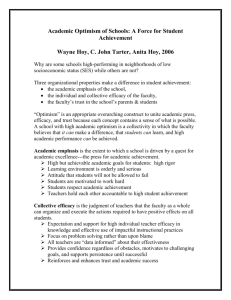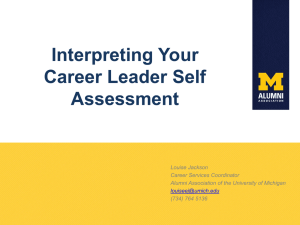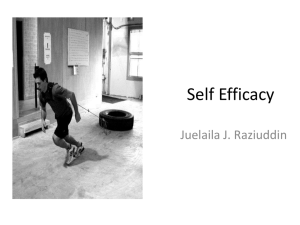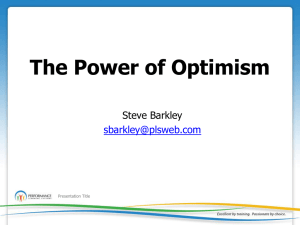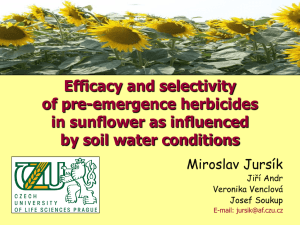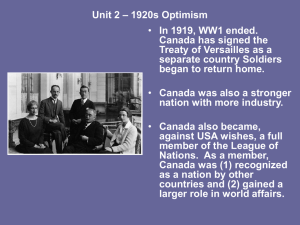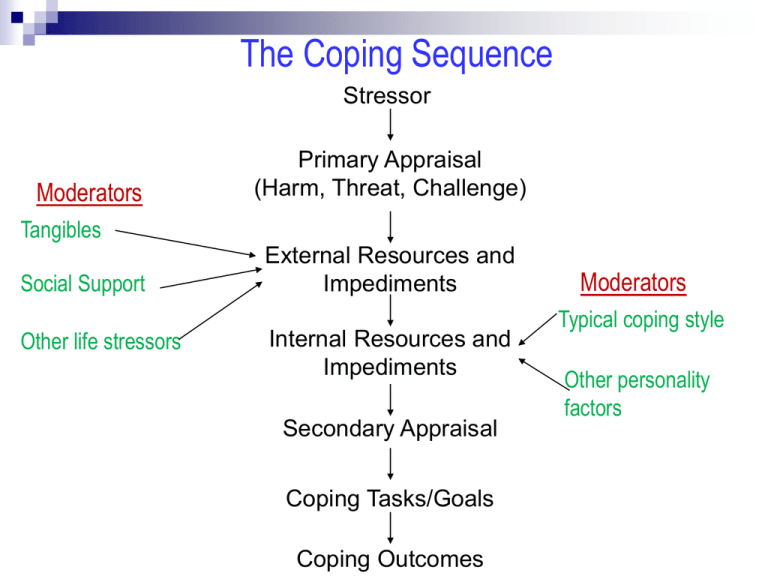
The Coping Sequence
Stressor
Moderators
Primary Appraisal
(Harm, Threat, Challenge)
Tangibles
Social Support
Other life stressors
External Resources and
Impediments
Internal Resources and
Impediments
Secondary Appraisal
Coping Tasks/Goals
Coping Outcomes
Moderators
Typical coping style
Other personality
factors
Negative Affect
(Watson, Clark, & Tellegen)
Defined: Pervasive negative mood marked by anxiety, depression,
and hostility.
Find many situations difficult to manage
Resort to unhealthy coping behaviors (such as?)
Related to poor health: asthma, arthritis, ulcers, headaches, CHD
Related to excess complaining:
a.
b.
c.
d.
More symptoms
Higher use of health services
Higher rates of self-reported illness
These people may compromise validity of self-reported illness
Class 10
Optimism, Part II
Announcements:
Read Kriegel Falling Into Life for Next Thurs.
About Reading Research Articles
1. Focus on Introduction and Discussion
2. Skim "Methods", know what was done.
3. Skip over "Results" section
Hardiness
Commitment: Get fully involved
Control: Strong internal Locus of Control (LOC)
Challenge: Seek out opportunities, meet challenges head on.
Why would these qualities moderate stress? Appraisal processes
Active, not avoidant
Hardiness and Executives Study
Kobassa, 1979
Subjects: 160 execs. under high stress, per Holmes & Rahe scale
Group A (n = 86) experiences stress but no illness
Group B (n = 75) experiences stress with illness
Illness measured by self report.
What distinguishes Group A from Group B?
Kobassa sends execs questionnaire:
a. Internal/external LOC
b. Commitment to life challenges
c. Change as challenge rather than threat.
Responses confirm hardiness model: Control, commitment, challenge
Problems with this
study?
Illness self reported (High NA?)
Design is correlational
Relation Between Hardiness and Coping
Kobasa, 1979
High Stress/
Low Illness
High Stress/
High Illness
CONTROL
Nihilism
Hardy
<
Not Hardy
External LOC
Hardy
<
Not Hardy
Powerlessness
Hardy
<
Not Hardy
Hardy
<
Not Hardy
Vegetativeness
Hardy
<
Not Hardy
Adventurousness
Hardy
>
Not Hardy
Commitment
Alienation from Self
Challenge
Self Efficacy
Robt. Bandura
Efficacy, Stress, and Immunocompetence
Background:
Animals exposed to stressor (shock)
Group A: Believes has control
Group B: Believes has NO control
Outcome: Opioids in system
Which animals produce MORE opioids?
Group B--No Control
Efficacy, Stress, and Immunocompetence
Stress --> ______
_____ --> opiods
ACTH path --> ______
adrenal stim --> cortisol
depress it
How do opioids affect immune system? ____________
Thus,
X
less control --> ___more
stress
OR ___ less stress -->
X
___more
opioids OR ___ less opioids -->
___ Immunocompetence OR
X Immunocompromise
___
Physiology of Stress
1. SAM: Sympathetic-adrenomedullary
Event cortex hypothalamus SNS adrenal medulla
catecholamines charged feeling increased BP, HR, etc.
SAM Corresponds to Cannon's stress model
2. HPA: Hypothlamic-pituitary-adreocortical
Event cortex hypothalamus coritcotrophin releasing factor (CRF)
pituitary adrencorticotropic hormone (ACTH) adrenal cortex
corticosteriods
conserves carbos
reduces inflammation
HPA corresponds to Selye's stress model
Evidence that Efficacy Moderates
Stress --> Illness Connection in Humans
Bandura, Cioffi, Taylor, & Brouillard, 1988
Predicted model:
Failure --> stress --> opioids --> less pain --> (immunocompromise)
Four groups:
1. Success, pain, opioid blocker
2. Success, pain, no opioid blocker
3. Failure, pain, opioid blocker
4. Failure, pain, no opioid blocker
Efficacy Manipulation
High Efficacy Group
Low Efficacy Group
(2 X 7 + 15)
(2 X 7 + 15)
(9 X 8 - 12)
(9 X 8 - 12)
(73 - 15 X 3)
(73 - 15 X 3)
At own pace
At preset, and
difficult, pace
40
30
20
10
0
-10
-20
-30
-40
-50
-60
-70
High Efficacy
Low Efficacy
Change in selfperceived math
efficacy
Psychological Effects of Math-Test
Manipulation
8
10
7
9
90
80
8
6
70
7
5
60
6
4
5
3
4
50
40
30
3
2
20
2
1
10
1
0
0
0
stress
Time Pressure
High Efficacy Condition
Low Efficacy Condition
Percieved Impairment Due to
Time Pressure
Opiate Blockage
Purpose: If stress increases opiates, and opiates reduce pain, then
X Low efficacy condition will have higher pain
___High efficacy OR ___
thresholds (i.e., be better able to withstand pain longer)?
HOWEVER, if opiates are blocked, which group should have higher pain
X High efficacy OR ___ Low efficacy?
thresholds, ____
To show this, need to block
opiates to some subjects
Naloxone: Opiate antagonist; 100% effective
Subs get Naloxone or saline. Why saline?
Experiment Design and Predictions
High Efficacy
Low Efficacy
Saline
(Placebo)
Blocker)
Naloxone
(Opiate
Moderate
Moderate
High Tolerance
Low Tolerance
Pain Threshold
(Ability to Tolerate Hand in Freezing Water)
Evidence that Efficacy Moderates
Stress --> Illness Connection in Humans
Bandura, Cioffi, Taylor, & Brouillard, 1988
Pain Tolerance
25
20
Placebo
Blocker
15
10
5
0
High Efficacy
Low Efficacy
Health Outcomes Questions
1. Compared to most other college students, what is your risk of an alcoholrelated injury?
Much
Below
Average
Below
Average
Slightly
Below
Average
Average
for
Rutgers
students
Slightly
Above
Average
Above
Average
Much
Above
Average
-3
-2
-1
0
+1
+2
+3
2. Compared to most other college students, what is your risk of getting
into a car accident?
Much
Below
Average
Below
Average
Slightly
Below
Average
Average
for
Rutgers
students
Slightly
Above
Average
Above
Average
Much
Above
Average
-3
-2
-1
0
+1
+2
+3
Denial and Coping
Psychological defense: Minimize or deny existence of threat
Is denial good or bad?
Good* Early in crisis
_______
Bad Chronic (ongoing)
_______
On-going denial can stop people from taking necessary action.
NMAD = Near Miss Asthma Death
Who denies more:
X Asthmatics who experienced NMAD
___
___ Regular Asthmatics
___ Non Asthmatics
* Sometimes
Denial Among NMAD Survivors,
“Regular” Asthmatics, and Non-Asthmatics
Yellowlees & Ruffin, 1989
5
Denial Level
4
3
2
1
0
NMAD
Regular Asthma
Normals
Denial and Health Indices Among NMAD Survivors
with or without Pre-existing Psychological Problems
Rating
Yellowlees & Ruffin, 1989
10
9
8
7
6
5
4
3
2
1
0
GHQ
MHQ
QOL
Psych. Probs.
HYPERVENT
Normals
DENIAL
Evidence of Improved Marital Relations
Following NMAD
(????)
“He has been less violent since the attack. He plays
with me now by twisting my arm up my back as a joke
rather than by badly bruising me”.
Optimists vs. Pessimists
Optimists
1. Expect positive outcomes
2. Expect to cope with adversity
Pessimists
1. Expect negative outcomes
2. Do not expect to cope with adversity
Pessimistic vs. Optimistic Attribution Styles
Joe Pessi
Robert Optiheimer
I bombed the math test.
I bombed the math test.
I just couldn't get myself to study.
All the noise outside my
apartment made it hard to study
A
I don't have good math ability, is what
it is.
I didn't really try as hard as I
could have.
B
Basically, I'm just not academically
skilled.
Math is my one weak area.
C
A. Internal vs. External Cause
B. Stable vs. Transitory Cause
C. Global vs. Specific Cause
Optimistic and Pessimistic Explanatory Styles
Success
Failure
Internal Cause
Optimist
Pessimist
External Cause
Pessimist
Optimist
Stable Cause
Optimist
Pessimist
Transitory Cause
Pessimist
Optimist
Explanatory Causes and Styles
I won the tennis match because my opponent wasn’t trying hard.
X External cause
___Internal cause
___
I lost my keys because I'm such a flake.
X
___Internal
cause
___ External cause
I showed up late for my date because I didn’t plan far enough in advance..
X Transitory Cause
___ Stable Cause
___
I showed up late for my date because I am so bad at planning.
X Stable Cause
___
___ Transitory Cause
My cholesterol went up because I’m not exercising.
X Specific Cause
___
___ Global Cause
My cholesterol went up because I’m a lazy slob.
X Global Cause
___ Specific Cause
___
Optimism Measure
Scheier, M.F., Carver, C.S., & Bridges, M.W. (1994)
1.
2.
3.
4.
In uncertain times, I usually expect the best.
It's easy for me to relax. (Filler item)
If something can go wrong for me, it will. *
I'm always optimistic about my future.
5.
6.
7.
I enjoy my friends a lot. (Filler item)
It's important for me to keep busy. (Filler item)
I hardly ever expect things to go my way. *
8.
I don't get upset too easily. (Filler item)
9.
10.
I rarely count on good things happening to me.*
Overall, I expect more good things to happen to me than bad.
Kurt Lewin: Morale, Not Simply Optimism
Diagnosed with
heart disease risk
Hope
I will improve
heart health
Morale
Diagnosed with
heart disease risk
I’ll sign up at a gym
I’ll change diet
I’ll meet MD
every 3 mos
I will improve
heart health
C. Synder "Hope" Measure
(Really a Measure of Morale)
P _____ 1. I can think of many ways to get out of a jam.
A _____ 2. I energetically pursue my goals.
F _____ 3. I feel tired most of the time.
P _____ 4. There are lots of ways around any problem.
F _____ 5. I am easily downed in an argument.
P _____ 6. I can think of many ways to get the things in life that are most important to me.
F _____ 7. I worry about my health.
P _____ 8. Even when others get discouraged, I know I can find a way to solve my problem.
A _____ 9. My past experiences have prepared me well for my future.
A _____10. I've been pretty successful in life.
F _____11. I usually find myself worrying about something.
A _____12. I meet the goals that I set for myself.
-------------------------A = Agency
F = Filler
P = Pathways
Optimism, Pessimism, and Ambulatory BP
Raikkonen, et al. (1999)
Prediction: Optimism and trait anxiety increased ambulatory BP
Subjects:
100 volunteers, 50% female, ave. age = 37
80% white, 10% black, 10% other
Procedure
1. Pre-assessment
a. Resting BP
b. Complete survey battery
1. Optimism (LOT)
2. Trait anxiety
3. Other background
2. Daily Monitoring
a. Wear BP device, 3 days, activates every 30”
b. Daily diary: Mood, Context (where, what doing,...)
Results of Raikkonen, et al. (1999)
1. Optimism
Pessimists have higher BP
Mood affects only optimists
2. Trait Anxiety
High anxious higher BP
Mood affects only low anxious
170
160
150
140
130
120
110
100
90
80
Pos Mood
Neg Mood
Pessimists
Optimists
3. Conclusions
Fabricated Data
for Illustration
a. Results real, not due to posture, activity, etc.
b. Chronic high BP is a health risk: can lead to
hypertension
c. Pessimists and high anxious may be at greater
long-term health risk
d. NA is a real health risk, not just a “whining” artifact.
Is Optimism Always a Good Thing?
Illusion of Invulnerability
Defined: Belief that one is immune from bad events, or that one will not be injured or
harmed even when taking risks.
Arises from:
1. Easier to think up things that reduce risk than things that increase risk.
2. Lack of info about others' risk prevention efforts.
3. Egocentric dismissal of other's efforts to reduce risk.
Weinstein Unrealistic Optimism Study
GROUP 1
COMPLETE INFO.: ABOUT ME AND ABOUT OTHERS
Your Risk Factor for Heart Attack
1. Cigarettes smoked per week
2. # Family members with heart ailments
3. Hours of exercise per week
Me
_____
_____
_____
GROUP 2
PARTIAL INFO: ABOUT ME ONLY, NO COMPARISON TO OTHERS
Your Risk Factor for Heart Attack
Me
1. Cigarettes smoked per week
_____
2. # Family members with heart ailments _____
3. Hours of exercise per week
_____
GROUP 3
NO INFO: NO TRACKING OF SELF, NO COMPARISON TO OTHERS
------------------------------------------------------------------------------------------
Others
(8)
(2)
(3)
Others
?
?
?
Weinstein Unrealistic Optimism Study
All subjects next answer the following question:
Compared to other Rutgers students of my sex,
my chances of having a heart attack are:
Much Below
Average
-3
Below
Average
Slightly
Below
Average
Average for
Rutgers
students
Slightly
Above
Average
Above
Average
Much
Above
Average
-2
-1
0
+1
+2
+3
Results of Weinstein Study
2
1
Complete Info
Partial Info
No Info
0
-1
-2
Heart Attack
Tooth Decay
Health Outcomes Questions
1. Compared to most other college students, what is your risk of an alcoholrelated injury?
Much
Below
Average
Below
Average
Slightly
Below
Average
Average
for
Rutgers
students
Slightly
Above
Average
Above
Average
Much
Above
Average
-3
-2
-1
0
+1
+2
+3
2. Compared to most other college students, what is your risk of getting
into a car accident?
Much
Below
Average
Below
Average
Slightly
Below
Average
Average
for
Rutgers
students
Slightly
Above
Average
Above
Average
Much
Above
Average
-3
-2
-1
0
+1
+2
+3
Risk of Alcohol Injury, Compared to Most Students
20
18
16
14
12
10
8
6
4
2
0
Much Below
Below
Slightly
Below
Average
Slightly
Above
Above
Much Above
n = 48
Mean = 2.46 Median = 2.00 Mode = 1 SD = 1.64


